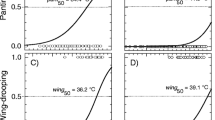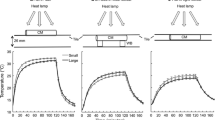Abstract
Heterothermy, a variability in body temperature beyond the normal limits of homeothermy, is widely viewed as a key adaptation of arid-adapted ungulates. However, desert ungulates with a small body mass, i.e. a relatively large surface area-to-volume ratio and a small thermal inertia, are theoretically less likely to employ adaptive heterothermy than are larger ungulates. We measured body temperature and activity patterns, using implanted data loggers, in free-ranging Arabian oryx (Oryx leucoryx, ±70 kg) and the smaller Arabian sand gazelle (Gazella subgutturosa marica, ±15 kg) inhabiting the same Arabian desert environment, at the same time. Compared to oryx, sand gazelle had higher mean daily body temperatures (F 1,6 = 47.3, P = 0.0005), higher minimum daily body temperatures (F 1,6 = 42.6, P = 0.0006) and higher maximum daily body temperatures (F 1,6 = 11.0, P = 0.02). Despite these differences, both species responded similarly to changes in environmental conditions. As predicted for adaptive heterothermy, maximum daily body temperature increased (F 1,6 = 84.0, P < 0.0001), minimum daily body temperature decreased (F 1,6 = 92.2, P < 0.0001), and daily body temperature amplitude increased (F 1,6 = 97.6, P < 0.0001) as conditions got progressively hotter and drier. There were no species differences in activity levels, however, both gazelle and oryx showed a biphasic or crepuscular rhythm during the warm wet season but shifted to a more nocturnal rhythm during the hot dry season. Activity was attenuated during the heat of the day at times when both species selected cool microclimates. These two species of Arabian ungulates employ heterothermy, cathemerality and shade seeking very similarly to survive the extreme, arid conditions of Arabian deserts, despite their size difference.







Similar content being viewed by others
References
Ahmed MMM, El Kheir IM (2004) Thermoregulation and water balance as affected by water and food restrictions in Sudanese desert goats fed good-quality and poor-quality diets. Trop Anim Health Prod 36:191–204
Aschoff J (1982) The circadian rhythm of body temperature as a function of body size. In: Taylor CR, Johansen K, Bolis L (eds) A companion to animal physiology. Cambridge University Press, New York, pp 173–189
Bartholomew GA (1964) The roles of physiology and behaviour in the maintenance of homeostasis in the desert environment. In: Hughes GM (ed) Symposia of the society of experimental biology: homoestasis and feedback mechanisms, vol 18. Cambridge University Press, Cambridge, pp 7–29
Belovsky GE, Jordan PA (1978) The time-energy budget of a moose. Theor Pop Biol 14:76–104
Belovsky GE, Slade JB (1986) Time budgets of grassland herbivores: body size similarities. Oecologia 70:53–62
Bunnell FL, Gillingham MP (1985) Foraging behavior: dynamics of dining out. In: Hudson RJ, White CR (eds) Bioenergetics of wild herbivores. CRC Press, Inc., Boca Raton, pp 53–79
Cain JW, Jansen BD, Wilson RR, Krausman PR (2008) Potential thermoregulatory advantages of shade use by desert bighorn sheep. J Arid Environ 72:1518–1525
Choshniak I, Ben-Kohav N, Taylor CR, Robertshaw D, Barnes RJ, Dobson A, Belkin V, Shkolnik A (1995) Metabolic adaptations for desert survival in the Bedouin goat. Am J Physiol Regul Integr Comp Physiol 268:R1101–R1110
Clarke A, Rothery P (2008) Scaling of body temperature in mammals and birds. Funct Ecol 22:58–67
Cunningham P, Sher Shah M, ul-Islam Z, Robinson R, al Boug A (2008) Adaptive management a prerequisite for the reintroduction of sand gazelle in Saudi Arabia. Gnusletter 27:19–22
Dawson TJ, Blaney CE, McCarron HCK, Maloney SK (2007) Dehydration, with and without heat, in kangaroos from mesic and arid habitats: different thermal responses including varying patterns in heterothermy in the field and laboratory. J Comp Physiol B Biochem Syst Environ Physiol 177:797–807
Demment MW, Van Soest PJ (1985) A nutritional explanation for body-size patterns of ruminant and non-ruminant herbivores. Am Nat 125:641–672
du Toit JT (1993) The feeding ecology of a very small ruminant, the steenbok (Raphicerus campestris). Afr J Ecol 31:35–48
du Toit JT, Yetman CA (2005) Effects of body size on the diurnal activity budgets of African browsing ruminants. Oecologia 143:317–325
Fick LG, Kucio TA, Fuller A, Matthee A, Mitchell D (2009) The relative roles of the parasol-like tail and burrow shuttling in thermoregulation of free-ranging Cape ground squirrels, Xerus inauris. Comp Biochem Physiol A Comp Physiol 152:334–340
Fuller A, Kamerman PR, Maloney SK, Matthee A, Mitchell G, Mitchell D (2005) A year in the thermal life of a free-ranging herd of springbok Antidorcas marsupialis. J Exp Biol 208:2855–2864
Grigg G, Beard L, Dorges B, Heucke J, Coventry J, Coppock A, Blomberg S (2009) Strategic (adaptive) hypothermia in bull dromedary camels during rut; could it increase reproductive success? Biol Lett 5:853–856
Groves CP (1988) A catalogue of the genus Gazelle. In: Dixon A, Jones D (eds) Conservation and biology of desert antelope, including the proceedings of the 25th anniversary celebration of ‘operation oryx’ symposium. Christopher Helm, London
Hansen MC (1982) Desert bighorn sheep: another view. Wildl Soc Bull 10:133–140
Hetem RS, Maloney SK, Fuller A, Meyer LCR, Mitchell D (2007) Validation of a biotelemetric technique, using ambulatory miniature black globe thermometers, to quantify thermoregulatory behaviour in ungulates. J Exp Zool 307A:342–356
Hetem RS, Strauss WM, Fick LG, Maloney SK, Meyer LCR, Shobrak M, Fuller A, Mitchell D (2010) Variation in the daily rhythm of body temperature of free-living Arabian oryx (Oryx leucoryx): does water limitation drive heterothermy? J Comp Physiol B Biochem Syst Environ Physiol 180:1111–1119
Jarman PJ (1977) Behavior of Topi in a shadeless environment. Zool Afric 12:101–111
Jeschke JM, Tollrian R (2005) Predicting herbivore feeding times. Ethology 111:187–206
Kamau JM, Maloiy GM (1985) Thermoregulation and heat balance in the dik–dik antelope (Rhynchotragus kirki): a field and laboratory study. Comp Biochem Physiol A Comp Physiol 81:335–340
Klein DR, Fairall N (1986) Associated energetics of impala and blesbok. J Appl Ecol 23:489–502
Leuthold BM, Leuthold W (1978) Daytime activity patterns of gerenuk and giraffe in Tsavo National Park, Kenya. E Afr Wildl J 16:231–243
Louw GN, Seely MK (1982) Ecology of desert organisms. Longman, New York
Maloney SK, Fuller A, Kamerman PR, Mitchell G, Mitchell D (2004) Variation in body temperature in free-ranging western grey kangaroo Macropus fuliginosus. Aust Mammal 26:135–144
Maloney SK, Fuller A, Meyer LCR, Kamerman PR, Mitchell G, Mitchell D (2011) Minimum daily core body temperature in western grey kangaroos decreases as summer advances: a seasonal pattern, or a direct response to water, heat or energy supply? J Exp Biol 214:1813–1820
McCutchen HE (1981) Desert bighorn zoogeography and adaptation in relation to historic land uses. Wildl Soc Bull 9:171–179
McNab BK (1970) Body weight and the energetics of temperature regulation. J Exp Biol 53:329–348
McNab BK (1983) Energetics, body size, and the limits to endothermy. J Zool Lond 199:1–29
Mitchell D, Maloney SK, Jessen C, Laburn HP, Kamerman PR, Mitchell G, Fuller A (2002) Adaptive heterothermy and selective brain cooling in arid-zone mammals. Comp Biochem Physiol B Biochem Mol Biol 131:571–585
Morrison PR, Ryser FA (1952) Weight and body temperature in mammals. Science 116:231–232
Mortola JP, Lanthier C (2004) Scaling the amplitudes of the circadian pattern of resting oxygen consumption, body temperature and heart rate in mammals. Comp Biochem Physiol A Comp Physiol 139:83–95
Mysterud A (1998) The relative roles of body size and feeding type on activity time of temperate ruminants. Oecologia 113:442–446
Ostrowski S, Williams JB (2006) Heterothermy of free-living Arabian sand gazelles (Gazella subgutturosa marica) in a desert environment. J Exp Biol 209:1421–1429
Ostrowski S, Williams JB, Ismael K (2003) Heterothermy and the water economy of free-living Arabian oryx (Oryx leucoryx). J Exp Biol 206:1471–1478
Ostrowski S, Mesochina P, Williams J (2006) Physiological adjustments of sand gazelles (Gazella subgutturosa) to a boom or bust economy: standard fasting metabolic rate, total evaporative water loss, and changes in the sizes of organs during food and water restriction. Physiol Biochem Zool 79:810–819
Owen-Smith N (1988) Megaherbivores: the influence of very large body size on ecology. Cambridge University Press, Cambridge
Owen-Smith N (1992) Grazers and browsers: ecological and social contrasts among African ruminants. In: Spitz F, Janeau G, Gonzalez G, Aulagnier S (eds) Ongulés/Ungulates 91. SFEPM-IRGM, Toulouse, pp 175–181
Owen-Smith N (1998) How high ambient temperature affects the daily activity and foraging time of a subtropical ungulate, the greater kudu (Tragelaphus strepsiceros). J Zool Lond 246:183–192
Pérez-Barbería FJ, Gordon IJ (1999) The relative roles of phylogeny, body size and feeding style on the activity time of temperate ruminants: a reanalysis. Oecologia 120:193–197
Peters RH (1983) The ecological implications of body size. Cambridge University Press, New York
Phillips PK, Heath JE (1995) Dependency of surface temperature regulation on body size in terrestrial mammals. J Therm Biol 20:281–289
Piccione G, Caola G, Refinetti R (2002) Circadian modulation of starvation-induced hypothermia in sheep and goats. Chronobiol Int 19:531–541
Roberts SC, Dunbar RIM (1991) Climatic influences on the behavioural ecology of Chanler’s mountain reedbuck in Kenya. Afr J Ecol 29:316–329
Rodbard S (1950) Weight and body temperature. Science 111:465–466
Sargeant GA, Eberhardt LE, Peek JM (1994) Thermoregulation by mule deer (Odocoileus hemionus) in arid rangelands of southcentral Washington. J Mammal 75:536–544
Schmidt-Nielsen K (1984) Scaling: why is animal size so important? Cambridge University Press, New York
Schmidt-Nielsen K, Schmidt-Nielsen B, Jarnum SA, Houpt TR (1957) Body temperature of the camel and its relation to water economy. Am J Physiol 188:103–112
Spalton JA (1999) The food supply of Arabian oryx (Oryx leucoryx) in the desert of Oman. J Zool Lond 248:433–441
Stanley Price MR (1989) Animal reintroductions: the Arabian oryx in Oman. Cambridge University Press, Cambridge
Tattersall I (2006) The concept of cathemerality: history and definition. Folia Primatol 77:7–14
Taylor CR (1970) Strategies of temperature regulation: effect on evaporation in East African ungulates. Am J Physiol 219:1131–1135
Taylor CR, Lyman CP (1967) A comparative study of the environmental physiology of an East African antelope, the eland and the Hereford steer. Physiol Zool 40:280–295
Taylor WA, Skinner JD, Krecek RC (2006) The activity budgets and activity patterns of sympatric grey rhebok and mountain reedbuck in a highveld grassland area of South Africa. Afr J Ecol 44:431–437
Tull JC, Krausman PR, Steidl RJ (2001) Bed-site selection by desert mule deer in southern Arizona. Southwest Nat 46:354–357
White CR, Seymour RS (2003) Mammalian basal metabolic rate is proportional to body mass2/3. Proc Nat Acad Sci 100:4046–4049
Wilson RT (1989) Ecophysiology of the Camelidae and desert ruminants. Springer, New York
Zervanos SM, Hadley NF (1973) Adaptational biology and energy relationships of the collared peccary (Tayassu tajacu). Ecology 54:759–774
Acknowledgments
We thank the National Commission for Wildlife Conservation and Development (NCWCD), Riyadh, Saudi Arabia, in particular the director His Royal Highness Prince Saud Al Faisal, the current secretary-general, His Highness Prince Bander Bin Saud, and the secretary-general at the time the study was conducted, Professor AH Abuzinada, for supporting the research. From the National Wildlife Research Center (NWRC), we are grateful to Dr Saud Anagariyah for his support in capturing the oryx and the current director, Ahmad Al Bouq. In addition, we thank the Mahazat as-Sayd Protected Area rangers for monitoring the animals and the mammal keepers at NWRC for their help with animal handling and assistance during surgery. This research was funded by the National Research Foundation, South Africa, the University of the Witwatersrand Medical Faculty Research Endowment Fund and a START/PACOM African PhD fellowship awarded to RS Hetem.
Author information
Authors and Affiliations
Corresponding author
Additional information
Communicated by G. Heldmaier.
Rights and permissions
About this article
Cite this article
Hetem, R.S., Strauss, W.M., Fick, L.G. et al. Does size matter? Comparison of body temperature and activity of free-living Arabian oryx (Oryx leucoryx) and the smaller Arabian sand gazelle (Gazella subgutturosa marica) in the Saudi desert. J Comp Physiol B 182, 437–449 (2012). https://doi.org/10.1007/s00360-011-0620-0
Received:
Revised:
Accepted:
Published:
Issue Date:
DOI: https://doi.org/10.1007/s00360-011-0620-0




